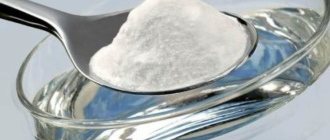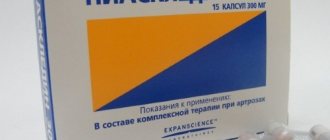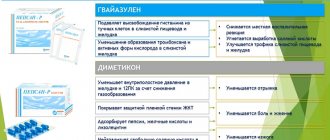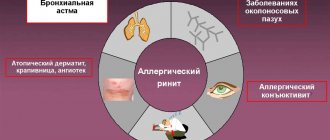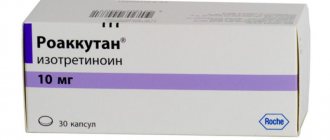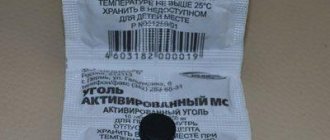What are the causes of leg cramps at night with varicose veins?
Experts name several reasons. Firstly, this is a violation of blood flow in the veins, which is inevitable with varicose veins. The blood stagnates, the pressure in the veins increases, and water leaks into the surrounding tissues. But with water you also get microelements that are needed for normal muscle contraction - potassium, calcium and sodium. As a result, the muscles begin to contract spontaneously, and these are cramps.
Secondly, with varicose veins, blood flow in the veins is difficult, and at night it becomes as slow as possible. Muscles may begin to contract in impulses to “push” blood through the vessels.
And thirdly, there is another, slightly more complex mechanism. The point is not only that the muscle contracts, but also that it does not relax. Special molecules in the body are responsible for relaxing muscles - ATP. When blood stagnates in the veins, ATP production decreases and the mechanism that “relaxes” the muscle fails.
Choice of pharmacological therapy for spastic muscle hypertonicity
The main drugs used to reduce muscle tone are muscle relaxants. According to the mechanism of action, muscle relaxants are distinguished between central action (affect the synaptic transmission of excitation in the central nervous system) and peripheral action (inhibit the direct excitability of striated muscles). When using muscle relaxants, quite significant side effects can occur, which must be carefully assessed when choosing a drug [1, 2].
When choosing antispastic drugs, they mainly take into account their ability to inhibit polysynaptic reflexes (reducing spasticity), while having the least effect on monosynaptic reflexes (muscle strength). An antispastic drug should reduce muscle spasticity with a minimal decrease in muscle strength [3, 4].
Drug therapy is based on the use of tablet and injection forms. Antispastic agents used internally, by reducing muscle tone, can improve motor functions, facilitate care for an immobilized patient, relieve painful muscle spasms, enhance the effect of physical therapy, and prevent the development of contractures [5]. With mild spasticity, the use of muscle relaxants can lead to a significant positive effect, but with severe spasticity, large doses of muscle relaxants may be required, the use of which often causes unwanted side effects. Treatment with muscle relaxants begins with a minimum dose, then it is slowly increased to achieve effect [6].
The centrally acting muscle relaxants most often used in Russia for the treatment of spastic muscle hypertonicity include baclofen, tizanidine, tolperisone, and diazepam [7, 8].
Baclofen (Baklosan, Lioresal) has an antispastic effect mainly at the spinal level. The drug is an analogue of gamma-aminobutyric acid (GABA), which binds to presynaptic GABA receptors, leading to a decrease in the release of excitatory amino acids (glutamate, aspartate) and suppression of mono- and polysynaptic activity at the spinal level, which causes a decrease in spasticity. The drug also exhibits a moderate central analgesic effect. Baclofen is used for spinal and cerebral spastic muscle hypertonicity of various origins. The initial dose is 5–15 mg/day (in one or three doses), then the dose is increased by 5 mg every day until the desired effect is obtained. The drug is taken with meals. The maximum dose of baclofen for adults is 60–75 mg/day. Side effects often include sedation, drowsiness, decreased concentration, dizziness, and often subside during treatment. Nausea, constipation and diarrhea, arterial hypertension, increased ataxia, and the appearance of paresthesia may occur. Caution is required when treating elderly patients, patients who have had a stroke, patients with gastric and duodenal ulcers. Baclofen is contraindicated in case of epilepsy or a history of seizures [9, 10].
For severe spasticity, when the usual oral use of antispastic drugs is not effective, intrathecal administration of baclofen is indicated, which was first proposed in 1984 by R. Penn. To achieve the required concentration of the drug in the cerebrospinal fluid, it is necessary to take quite significant doses of baclofen, which can lead to disturbances of consciousness, drowsiness, and weakness. Therefore, systems have been developed that deliver baclofen directly into the intrathecal space of the spinal cord using the intrathecal baclofen pump system. In this case, the clinical effect is achieved with much smaller doses of baclofen than when using tablet forms [11, 12].
This system consists of a reservoir containing baclofen or a similar drug, a pump (pump), with the help of which the drug is dosed into the intrathecal space of the spinal cord through a lumbar catheter and a power supply. From the reservoir, baclofen enters directly into the cerebrospinal fluid, and its dosage is controlled by a special radiotelemetry device. The amount of drug entering the cerebrospinal fluid can be changed depending on the clinical picture. Baclofen is added to the reservoir after 2–3 months using percutaneous puncture [13].
The use of a baclofen pump improves the speed and quality of walking of patients with unfixed reflex contractures caused by high spasticity of synergistic muscles and imbalance of antagonist muscles. The existing 15-year clinical experience of using baclofen intrathecally in patients who have suffered a stroke indicates the high effectiveness of this method in reducing not only the degree of spasticity, but also pain syndromes and dystonic disorders. A positive effect of the baclofen pump on the quality of life of stroke patients was noted [14].
Tizanidine (Sirdalud) is a centrally acting muscle relaxant, an alpha-2 adrenergic receptor agonist. The drug reduces spasticity due to suppression of polysynaptic reflexes at the level of the spinal cord, which can be caused by inhibition of the release of excitatory amino acids L-glutamate and L-aspartate and activation of glycine, which reduces the excitability of spinal cord interneurons. Tizanidine also has a moderate central analgesic effect. The drug is effective for cerebral and spinal spasticity, as well as for painful muscle spasms. The initial dose of the drug is 2–6 mg/day in one or three doses; with individual selection, the dose is increased on days 3–4 by 2 mg. When taken orally, the effect of the drug appears within 30–45 minutes, the maximum effect occurs within 1–2 hours. The average therapeutic dose is 12–24 mg/day, the maximum dose is 36 mg/day. Side effects may include drowsiness, dry mouth, dizziness and decreased blood pressure, which limits the use of the drug for post-stroke spasticity. The antispastic effect of tizanidine is comparable to the effect of baclofen, however, tizanidine, with adequate dosage selection, is better tolerated, since it does not cause general muscle weakness and does not increase muscle weakness in the paralyzed limb [15, 16].
Tolperisone (Mydocalm) is a centrally acting antispastic drug that inhibits the caudal part of the reticular formation and has N-cholinolytic properties. Tolperisone reduces the activity of spinal neurons involved in spasticity by limiting the flow of sodium across the nerve cell membrane. The most commonly used dose is 300–450 mg/day in two or three doses. A decrease in muscle tone when tolperisone is prescribed is sometimes accompanied by a vasodilator effect, which should be taken into account when prescribing to patients with a tendency to arterial hypotension. The drug can also cause or worsen urinary incontinence in patients [17].
The main side effect of baclofen, tizanidine and tolperisone is the rapid onset of muscle weakness, and in each case the doctor must find a balance between decreased tone and increased weakness. The balance curve between a decrease in spastic tone and an increase in muscle weakness in patients with an increase in the dose of Mydocalm, Sirdalud or Baclofen shows that the most rapid increase in weakness occurs when taking Baclofen, and the mildest drug that allows you to effectively select an individual dosage is Mydocalm. In all cases, given the presence of a narrow therapeutic window, the course of treatment begins with a small dose of the drug, gradually increasing it until a clear antispastic effect is achieved, but not until weakness appears [18, 19].
Diazepam (Realanium, Relium, Sibazon) is a muscle relaxant because it has the ability to stimulate reduced presynaptic inhibition at the spinal level. It does not have direct GABAergic properties, increases the concentration of acetylcholine in the brain and inhibits the reuptake of norepinephrine and dopamine at synapses. This leads to increased presynaptic inhibition and is manifested by a decrease in stretch resistance and an increase in range of motion. Diazepam also has the ability to reduce pain caused by muscle spasms. Along with a decrease in muscle tone, lethargy, dizziness, impaired attention and coordination develop due to the toxic effect on the central nervous system. This significantly limits the use of diazepam as a muscle relaxant. It is used mainly for the treatment of spasticity of spinal origin when a short-term decrease in muscle tone is necessary. For the treatment of spasticity, a dose of 5 mg once or 2 mg 2 times a day is prescribed. The maximum daily dose can be 60 mg. At high doses, disturbances of consciousness, transient liver dysfunction and blood changes may occur. The duration of treatment is limited due to the possible development of drug dependence [20].
Clonazepam is a benzodiazepine derivative. Clonazepam has a sedative, central muscle relaxant, and anxiolytic effect. The muscle relaxant effect is achieved by enhancing the inhibitory effect of GABA on the transmission of nerve impulses, stimulating benzodiazepine receptors located in the allosteric center of the postsynaptic GABA receptors of the ascending activating reticular formation of the brain stem and interneurons of the lateral horns of the spinal cord, as well as reducing the excitability of the subcortical structures of the brain and inhibition of polysynaptic spinal reflexes.
The rapid onset of drowsiness, dizziness and addiction limits the use of this drug. To reduce the occurrence of possible adverse reactions, it is necessary to achieve a therapeutic dose by slow titration over two weeks. For oral administration to adults, an initial dose of no more than 1 mg/day is recommended. Maintenance dose: 4–8 mg/day. It is possible to prescribe small doses in combination with other muscle relaxants. Clonazepam is effective for paroxysmal increases in muscle tone. Contraindicated in acute diseases of the liver, kidneys, myasthenia gravis [21].
Dipotassium clorazepate (Tranxen) is a benzodiazepine analogue, transforms into the main metabolite of diazepam, has greater activity and duration of antispastic action than diazepam. It has been noted to have a good effect in treatment in the form of a decrease in phasic stretch reflexes and has a slight sedative effect. The initial dose is 5 mg 4 times a day, then reduced to 5 mg 2 times a day [22].
Dantrolene is an imidazoline derivative that acts outside the central nervous system, mainly at the level of muscle fibers. The mechanism of action of dantrolene is to block the release of calcium from the sarcoplasmic reticulum, which leads to a decrease in the degree of contractility of skeletal muscles, a reduction in muscle tone and phasic reflexes, and an increase in the range of passive movements. An important advantage of dantrolene in relation to other muscle relaxants is its proven effectiveness against spasticity not only of spinal, but also of cerebral origin. The initial dose is 25 mg/day; if tolerated, the dose is increased over 4 weeks to 400 mg/day. Side effects: drowsiness, dizziness, nausea, diarrhea, decreased glomerular filtration rate. A serious danger, especially in elderly patients at a dose of more than 200 mg/day, is the hepatotoxic effect, so liver function should be regularly monitored during treatment. Elimination of dantrolene is 50% due to hepatic metabolism, and therefore it is contraindicated in liver diseases. Caution should also be exercised in case of severe cardiac or pulmonary diseases.
Catapresan - used mainly for spinal injuries, acts on alpha-2 agonists in the brain, has presynaptic inhibition. Side effects include decreased blood pressure and depression. The initial dose is 0.05 mg 2 times a day, the maximum is 0.1 mg 4 times a day.
Temazepam - interacts with benzodiazepine receptors of the allosteric center of postsynaptic GABA receptors located in the limbic system, ascending activating reticular formation, hippocampus, interneurons of the lateral horns of the spinal cord. As a result, channels are opened for incoming currents of chlorine ions and thus the action of the endogenous inhibitory transmitter, GABA, is potentiated. The recommended dose is 10 mg 3 times a day. Its combination with baclofen is effective [23, 24].
The main drugs used to treat spastic muscle hypertonicity are presented in Table.
Thus, the choice of drug is determined by the underlying disease, the severity of muscle spasticity, as well as side effects and characteristics of the action of a particular drug.
For example, tizanidine and baclofen have a greater effect on the tone of the extensor muscles, therefore, in cases of significant hypertonicity of the flexor muscles of the arm, mild spasticity of the leg muscles, their use is not indicated, since a slight increase in the tone of the extensor muscles of the leg compensates for muscle weakness in the leg and stabilizes the patient's gait. In this case, the means of choice are methods of physical impact on the muscles of the upper limb.
In the treatment of cerebral spasticity, Sirdalud and Baclofen are most often used, and for spinal spasticity - Sirdalud and Baclofen. Mydocalm has an important advantage over other muscle relaxants, which does not have a sedative effect and has a favorable tolerability spectrum, therefore it is the drug of choice for treatment on an outpatient basis and for the treatment of elderly patients.
A combination of several drugs is acceptable, which allows you to effectively reduce tone at lower doses of each drug. Combining drugs with different points of application, from centers in the brain to muscles, can lead to a cumulative therapeutic effect.
The effectiveness of oral antispastic drugs decreases with their long-term use; there is often a need for increasing dosages to maintain the initial clinical effect, which is accompanied by an increase in the frequency and severity of adverse reactions [25–27].
In a situation where spasticity is local in nature and the systemic effect of oral muscle relaxants is undesirable, local methods of exposure are preferable, one of which is the local administration of botulinum toxin [28, 29].
Literature
- Skoromets A. A., Amelin A. V., Pchelintsev M. V. et al. Prescription reference book for a neurologist. SPb: Polytechnic. 2000. 342 p.
- Shtok V.N. Pharmacotherapy in neurology: A practical guide. 4th ed., revised. and additional M.: Medical Information Agency LLC, 2006. 480 p.
- Methodological recommendations for organizing neurological care for patients with strokes in St. Petersburg / Ed. V. A. Sorokoumova. SPb: St. Petersburg, 2009. 88 p.
- Lehmann-Horn F., Ludolf A. Treatment of diseases of the nervous system. M.: MEDpress-inform. 2005. 528 p.
- O'Dwyer N., Ada L., Neilson P. Spasticity and muscle contractur in stroke // Brain. 2006. Vol. 119. P. 1737–1749.
- Damulin I.V. Spasticity syndrome and the main directions of its treatment // Journal of Neurology and Psychiatry named after. S. S. Korsakova. 2003. No. 12. P. 4–9.
- Zavalishin I. A., Barkhatova V. P., Shitikova I. E. Spastic paresis // In the book. Multiple sclerosis. Selected issues of theory and practice. Ed. I. A. Zavalishina, V. I. Golovkina. Elf IPR LLC. 2000. pp. 436–455.
- Levin O. S. Basic drugs used in neurology: Handbook. M.: MEDpress-inform, 2007. 336 p.
- Boyko A. N., Lashch N. Yu., Batysheva T. T. Increased muscle tone: etiology, pathogenesis, correction // Handbook of a polyclinic doctor. 2004. T. 4. No. 1. P. 28–30.
- Damulin I.V. Spasticity syndrome and the main directions of its treatment // Journal of Neurology and Psychiatry named after. S. S. Korsakova. 2003. No. 12. P. 4–9.
- Selected lectures on neurology: ed. V. L. Golubeva. M.: EidosMedia, 2006. 624 p.
- Parziale J., Akelman E., Herz D. Spasticity: pathophysiology and management // Orthopedics. 2003. Vol. 16. P. 801–811.
- Katz R., Rymer Z. Spastic hypertonia: mechanisms and measurement // Arch. Phys. Med. Rehab. 2009. Vol. 70. P. 144–155.
- Barnes M. An overview of the clinical management of spasticity // In: Upper motor neuron syndrome and spasticity. Cambridge University Press. 2001. P. 5–11.
- Parfenov V. A. Pathogenesis and treatment of spasticity // Russian Medical Journal. 2011. T. 9. No. 25. pp. 16–18.
- Kadykov A. S., Shakhparanova N. V. Drug rehabilitation of patients with spastic paresis. In the book: Upper motor neuron syndrome. Ed. I. A. Zavalishina, A. I. Osadchikh, Y. V. Vlasova. Samara: Samara department. Literary Fund, 2005. pp. 304–315.
- Kadykov A. S., Chernikova L. A., Sashina M. B. Rehabilitation of patients with central post-stroke pain syndrome // Rehabilitation. Collection of scientific works (annual publication), No. 1. M.: Publishing house RGMU, 2003. P. 357–359.
- Sashina M. B., Kadykov A. S., Chernikova L. A. Post-stroke pain syndromes // Atmosphere. Nervous diseases. 2004. No. 3. P. 25–27.
- Kamchatnov P.R. Spasticity - modern approaches to therapy // Russian Medical Journal. 2004. T. 12. No. 14. P. 849–854.
- Gusev E.I., Skvortsova V.I., Platinova I.A. Therapy of ischemic stroke // Consilium medicum. 2003, special release. pp. 18–25.
- Kadykov A. S., Chernikova L. A., Sashina M. B. Post-stroke pain syndromes // Neurological Journal. 2003. No. 3. P. 34–37.
- Musaeva L. S., Zavalishin I. A. Treatment of spasticity in multiple sclerosis // Proceedings of the 9th symposium “Multiple sclerosis: treatment and recovery.” SPb: Faces of Russia. 2000. pp. 59–60.
- Stroke. Principles of diagnosis, treatment and prevention / Ed. N.V. Vereshchagina, M.A. Piradova, Z.A. Suslina. M.: Intermedica, 2002. 208 p.
- Sommerfeld DK, Eek EU-B., Svensson A.-K. et al. Spasticity after stroke: its occurrence and association with motor impairments and activity limitations // Stroke. 2004. Vol. 35. P. 134–140.
- Bakheit A., Zakine B., Maisonobe P. The profile of patients and current practice of treatment of upper limb muscle spasticity with botulinum toxin type A // Int. J. Rehabil. Res. 2010. Vol. 33. P. 199–204.
- Malakhov V. A. Muscular spasticity in organic diseases of the nervous system and its correction // International Neurological Journal. 2010. No. 5. P. 67–70.
- Davis T., Brodsky M., Carter V. Consensus statement on the use of botulinum neurotoxin to treat spasticity in adults // Pharmacy and Therapeutics. 2006. Vol. 31. P. 666–682.
- Childers M., Brashear A., Jozefczyk P. Dose-dependent response to intra-muscular botulinum toxin type A for upper limb spasticity after stroke // Arch. Phys. Med. Rehab. 2004. Vol. 85. P. 1063–1069.
- Kadykov A. S. Muscle relaxants in the rehabilitation of patients with post-stroke motor disorders // Journal of Neurology and Psychiatry named after. S. S. Korsakova. 1997. No. 9. pp. 53–55.
A. A. Korolev, Candidate of Medical Sciences
FSBI All-Russian Center for Emergency and Radiation Medicine named after. A. M. Nikiforova" EMERCOM of Russia, St. Petersburg
Contact information about the author for correspondence
What are the causes of leg cramps during pregnancy?
Expecting a baby is certainly a happy, but at the same time difficult time. It is during this period that, as a result of weight gain, hormonal changes, and decreased activity, many expectant mothers develop varicose veins. Which becomes one of the causes of night cramps.
Please note: cramps during pregnancy are an alarming symptom. It may indicate a lack of microelements, may be a consequence of large fluid losses (for example, during toxicosis), convulsions occur if the growing uterus compresses the inferior vena cava, etc. The expectant mother should definitely consult a doctor who will accurately determine the causes of seizures.
results
Of the 166 patients, the final analysis included 94 (39% men, mean age 69 ± 11.1 years). Of these, 48 received magnesium oxide and 46 received placebo.
- The mean change in number of night cramps was −3.41 (4.05) (from 7.84 [5.68] to 4.44 [5.66]) and −3.03 (4.53) (from 8.51 [5.20] to 5.48 [4.93]) per week in the magnesium and placebo groups, respectively. . Difference between groups 0.38 (P = 0.67 in intention-to-treat analysis).
- No statistically significant differences were found between the groups in the severity and duration of seizures, quality of life and sleep indicators.
How to get rid of night leg cramps?
If you wake up at night from a sudden cramp, then the first desire is to rub your sore leg. Unfortunately, this does not always help relieve pain. How to relieve night leg cramps?
Lying down, you can do the following: pull the foot of the sore leg towards you, while simultaneously squeezing and unclenching the calf muscle with your palms (after all, it is usually the one that cramps). This will help to quickly relieve the attack. After this, work with the feet of both legs, make circular movements or alternately pull them towards you. This will activate blood circulation and the pain will go away.
Some people advise that if a cramp is very intense, try to relieve it by pricking your leg with a pin or needle. We doubt you'll have it handy while you sleep at night. But you can pinch yourself on the shin several times, although this can be difficult if the cramp is very strong
Also, if your leg cramps, you can stand on a bare, cool floor (but not on the carpet, the effect will not be the same) and try to walk. And when the muscle relaxes, still standing on the floor, shift from toe to heel for a minute. This simple exercise will help improve blood circulation.


